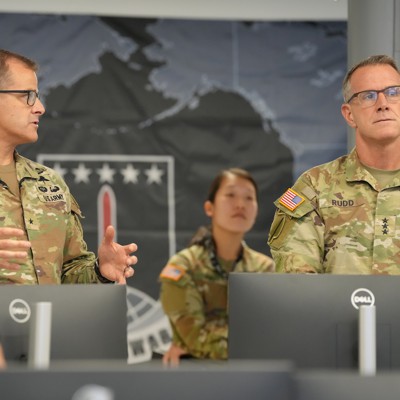HONOLULU—Drones that can fly long distances in stormy Pacific weather are at the top of the wishlist for the 3rd Multi-Domain Task Force, which is now part of the Army’s rapid experimentation and fielding “Transformation in Contact” program.
All three of the Army’s MDTFs are now part of TiC, combining the development of a new type of unit with the next generation of Army acquisitions.
“We know where our gaps are, and we live in them every single day,” Brig. Gen. Mike Rose, 3rd MDTF’s commander, told Defense One Tuesday at the AUSA Land Forces Pacific symposium. “The discussion now is about campaigning to identify those gaps, and to experiment with the capability that can help potentially fill those gaps, and then feed that back up into the machine.”
One of those key gaps is long-distance sensing, Rose said. U.S. Indo-Pacific Command covers about 100 million square miles, and while one platform doesn’t need to have eyes on every square inch, Army formations do need to be able to cover thousands of square miles in a conflict.
“Without getting into specific ranges, there’s really two considerations that I think about: No. 1, I have to be able to see as far as I can shoot,” Rose said.
To do that, the Army is looking at small, solar-powered, lightweight drones that are suited to INDOPACOM’s size and climate, Col. Charles Kean, who commands the 1st MDTF, told Defense One.
“Unheard of distances that we’re talking about, that we’re trying to achieve, and unheard of duration in the elements when, you know, at 12 o’clock noon, when you’re sitting in the Philippines this time of year, there’s a thunderstorm that comes rolling through,” he said.
The TiC program allows units to test out systems the larger Army has its eye on, but also allows individual units to request specific capabilities.
“So we have a pretty good idea of who’s working on what. So that’s a good place to start. You know, when you ask for stuff, generally speaking, the preferred method is to ask for capability,” Rose said. “And you know, what are your threshold and objective needs? And then the machine will kind of take over and find you that capability.”
Or, in the case of TiC 2.0, units operating in the U.S. and Europe have had a chance to give feedback to industry on systems in those environments and are now being tested in the Pacific, with a new set of demands.
“The 1.0 version of it that’s available now, we continue to incentivize the improvements on it to buy more of it at the 2.0 version, or potentially even competitor vendors, to come to the table with something that’s an improvement,” Rose said.
Read the full article here








Leave a Reply